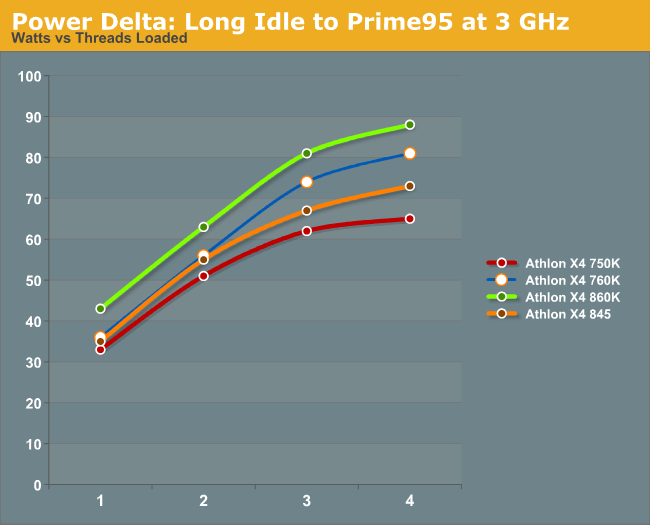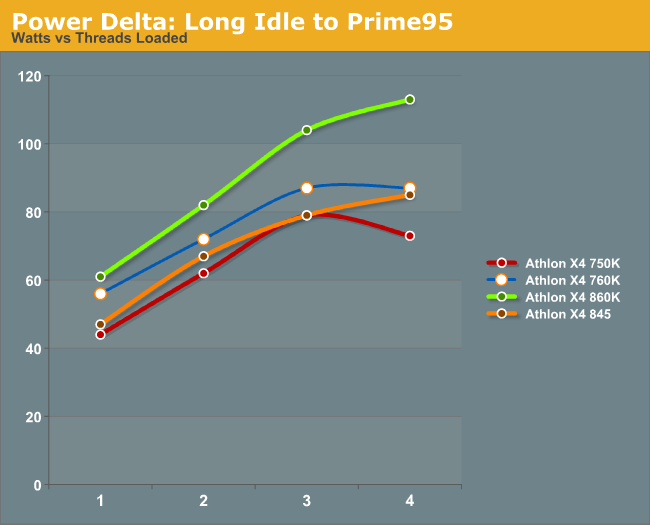AMD Carrizo Part 2: A Generational Deep Dive into the Athlon X4 845 at $70
by Ian Cutress on July 14, 2016 9:00 AM ESTPower Consumption
Power consumption was tested on the system while in a single MSI GTX 770 Lightning configuration with a wall meter connected to the power supply. This power supply is 80PLUS rated, and as I am in the UK on a 230-240 V supply, leads to ~75% efficiency > 50W, and 90%+ efficiency at 250W, suitable for both idle and multi-GPU loading. This method of power reading allows us to compare the power management of the UEFI and the board to supply components with power under load, and includes typical PSU losses due to efficiency.
Our Power Consumption tests have changed slightly since our last review as we are testing out new ways to represent the power used by the CPU and the system. The current three standard tests start with a system at long idle, meaning that the OS turns off the monitor and enters a lower power state without going into S3. We then move into a standard idle state on the desktop, with no software running but the desktop on display. The system is then moved into high performance mode, and we run a one-minute OCCT test to identify peak power consumption.
Due to extended requests, our power consumption numbers also use Prime95 to load the system. We use Prime95's peak power consumption mode, testing 1/2/3/4 thread consumption at the wall with our power meter. P95 hits the peak power relatively quickly, making this a straightforward test to include. For CPUs above 4 threads, we typically manage powers of two, half the CPU, and the full CPU to get an accurate picture.
For this review, we performed the power analysis for all four main CPUs at the 3 GHz frequency (using automatic voltage on the motherboard), as well as at stock frequencies. The values shown are delta values to the long idle power consumption, due to power delivery variations.
Generational Power Consumption at 3 GHz
All four processors have a 2-3W difference moving from a long idle to an idle state, however it is clear that our Carrizo CPU, which we stated is well outside its normal efficiency window at the beginning of this review, has a very good response during OCCT loading.

These results are within 3-4W of the full loading provided by Prime95 as well. If we analyze the per core jumps from moving up the threads using Prime95, there are some interesting numbers to pick out.

All the processors increase their power consumption by ~20W when both modules are loaded, when moving from 1 core loading to 2 core loading. When moving to 3/4 core loading, it is obvious that as both modules are already running at high frequency, a smaller amount of power is needed for each to enable the second thread.
Power Consumption at Stock
For those keeping track, we were not able to source identical TDP rated processors for this test. While the Carrizo based Athlon is 65W, the other processors are at the 95W/100W level. This makes total power consumption numbers relatively processional, and it becomes interesting looking into how close each processor gets to its TDP.
In our testing, the X4 845 seems to go beyond its 65W TDP, pushing almost another 9W through our power meter. This is only 8W away from the X4 750K, which should be 35W ahead. However, it would seem that for the X4 845, P95 draws an extra 15W compared to OCCT, but for the X4 750K, it draws 10W less, showing how difficult it can be to retain consistency. It is worth noting that TDP ratings are difficult to interpret in this way - the processors coming out of the fabs will have a statistical variation to their operating voltage, and this differs between samples. A good sample of a high TDP compared to a bad sample of a low TDP might seem to generate an interesting story, however without having access to several dozen units it can be strained to draw many conclusions.

Looking at the Prime95 core-loading numbers, we see a similar pattern to what happened at 3 GHz, despite the X4 760K getting the same power reading for 3/4 core loading and the X4 750K actually decreasing in power with four loaded threads.










131 Comments
View All Comments
The_Countess - Tuesday, July 19, 2016 - link
actually bulldozer on 14nm would have been a completely different beast. it would have allowed AMD to use far more transistors per core while still making it way smaller in terms of size. that would have allowed AMD to create a far wider execution core, eliminating most of its bottlenecks.the high latency cache would probably still means it wouldn't be great for games but for everything else it would be a far more competitive design.
it is also 14nm that will allow zen to make such a massive leap in IPC's as it will be a very wide Core, while still being pretty small, something that just can't be done on 28nm.
bulldozer might not have been the best idea, but being stuck on 32/28nm for so long made all it's issues infinitely worse.
nandnandnand - Thursday, July 14, 2016 - link
"Well better late than never for Andantech,"There was no point in Adanantech writing this review, because it is a chip for those people too stupid to wait until Zen. Zen is the only thing that matters.
BurntMyBacon - Friday, July 15, 2016 - link
@nandnandnand: "There was no point in Adanantech writing this review, because it is a chip for those people too stupid to wait until Zen. Zen is the only thing that matters."Now, because this review exists, people as yet uninformed have concrete data to avoid decisions that might make them look (as you put it) stupid. There is very much a point.
Byte - Thursday, July 14, 2016 - link
Zen will probably be the RX480 in the CPU world. Better performance, still trounced by the competition, but competently priced.looncraz - Friday, July 15, 2016 - link
That would be an improvement on the current situation. AMD is pricing their CPUs quite poorly right now.An Intel Celeron G3900 is $50 right now. AMD's closest competition is the A6-7400k - at $55.
Both are dual cores, both are 65W, both have middling (but usable) graphics performance... quite similar at first glance... except the Intel runs at 2.8Ghz and the AMD runs at 3.5Ghz w/ 3.9Ghz turbo and can rather easily exceed 4Ghz when overclocked.
Sounds like AMD should be taking home the gold on that one, until you find that the Celeron is nearly 25% faster in single threaded programs and is ~40% faster in multi-threaded programs... Bad deal going for the AMD... especially since the same board that hosts the Celeron can accept much faster CPUs and the AMD board simply doesn't have notably more powerful options available - you can upgrade to a quad core, but you won't be getting better single threaded performance no matter how hard you try. You might break even around 5Ghz, if you can manage it...
AMD has a 40% clock-speed advantage out the gate, but loses by a large margin.
bananaforscale - Friday, July 15, 2016 - link
You know what's funny? The fact that if I want to get a CPU that's faster than the FX-6100 I bought almost 5 years ago I still have to pay more than what I paid for it. Sure, Intel gives better single thread performance but I'd get fewer cores and no overclockability. Then there's the fact that I've been running that original Bulldozer with a 20% OC and it seems more stable than at stock clocks.Comparing single data points tells nobody a thing. Anyway, isn't that A6 in your comparison unlocked? :P
wumpus - Friday, July 15, 2016 - link
I'm sure you missed an FX-8320 sale, or you really nailed the low point. Unfortunately Intel can match AMD's performance at nearly the same price, and is cutting off AMD's air supply that way.artk2219 - Monday, July 18, 2016 - link
Whats crazy is that Microcenter sells the FX 8320E's for $89.99. They also have a motherboard bundle option that you can get for $125 to $170 depending on which board you choose. Theoretically you can get a processor, motherboard, cooler, and memory for the price of a non-K core I5, or just a motherboard and processor for the price of an I3. The unfortunate thing is that not everyone has a microcenter near them, but for the ones that do you can get quite the deal, especially since those 8320E's will easily OC to FX 8350 levels, and more likely 4.2 to 4.6 from a stock clock of 3.2BlueBlazer - Friday, July 15, 2016 - link
From the leaks plus AMD's vague announcements, all points to AMD's Zen is going to be quite late (right into 2017). Why put use 28nm "placeholder" for AM4 if Zen is due soon? Also Global Foundries only has 14nm LPP which is a low power process. That may mean the frequency is going to be low (just look at the chips made on 14nm LPP like Qualcomm's Snapdragon 820, or even AMD's latest Radeon RX480). Reference http://semiengineering.com/high-performance-and-lo... quote "The “LP” processes are optimized for low power and feature design rules targeted for the lowest leakage, support lower operative voltages, and tend to have the slowest transistors of the three options".wiboonsin - Sunday, November 12, 2017 - link
I have read your article, it is very informative and helpful for me.I admire the valuable information you offer in your articles. Thanks for posting http://www.fanaticrunningwear.com/